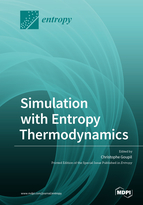Simulation with Entropy Thermodynamics
A special issue of Entropy (ISSN 1099-4300). This special issue belongs to the section "Thermodynamics".
Deadline for manuscript submissions: closed (30 September 2020) | Viewed by 36195
Special Issue Editor
Interests: out-of-equilibrium thermodynamics; solid-state physics; thermoelectricity; living systems; thermodynamics optimization; network thermodynamics; ecological economics
Special Issues, Collections and Topics in MDPI journals
Special Issue Information
Dear Colleagues
Energy conversion processes are at the heart of many of the challenges currently faced by our communities. Among them, the issues of entropy production and dissipation are particularly important. Not generally adhering to variational principles, the study of these processes remains an area that is not fully explored. The development of tools for simulating entropic processes, based on proven theoretical foundations, is a challenge, from both a fundamental and an applied point of view.
Among the issues discussed are those concerning the operating points of the processes, somewhere between minimizing and maximizing entropy production, or the famous principle of maximum power.
This Special Issue aims to address a broad audience, covering the sciences of condensed matter by including quantum aspects, the sciences of soft matter by including stochastic processes, and the sciences of life by including the optimization of unbalanced behaviors. In addition, a place will also be given to the economic sciences in their ecological dimension.
By considering this topic from multiple perspectives relating physical systems to engineering, living systems, or fundamental processes, this special volume aims to provide the reader with an overview of the associated issues, which are addressed by simulations.
The main topics of this Special Issue include (but not limited to):
* Entropy production, dissipation, and optimization
* Bond-graph and pseudo-bond-graph simulation
* Linear out-of-equilibrium processes
* Far form equilibrium, including large deviation processes
* Quantum Thermodynamics
* Network Thermodynamics
* Stochastic Thermodynamics
* Biological processes
* Entropy and Information
* Ecological Economics
Prof. Dr. Christophe Goupil
Guest Editor
Manuscript Submission Information
Manuscripts should be submitted online at www.mdpi.com by registering and logging in to this website. Once you are registered, click here to go to the submission form. Manuscripts can be submitted until the deadline. All submissions that pass pre-check are peer-reviewed. Accepted papers will be published continuously in the journal (as soon as accepted) and will be listed together on the special issue website. Research articles, review articles as well as short communications are invited. For planned papers, a title and short abstract (about 100 words) can be sent to the Editorial Office for announcement on this website.
Submitted manuscripts should not have been published previously, nor be under consideration for publication elsewhere (except conference proceedings papers). All manuscripts are thoroughly refereed through a single-blind peer-review process. A guide for authors and other relevant information for submission of manuscripts is available on the Instructions for Authors page. Entropy is an international peer-reviewed open access monthly journal published by MDPI.
Please visit the Instructions for Authors page before submitting a manuscript. The Article Processing Charge (APC) for publication in this open access journal is 2600 CHF (Swiss Francs). Submitted papers should be well formatted and use good English. Authors may use MDPI's English editing service prior to publication or during author revisions.
Keywords
- Out-of-equilibrium thermodynamics
- Solid-state physics
- Quantum thermodynamics
- Living systems
- Network Thermodynamics
- Bond-graph
- Ecological Economics.







